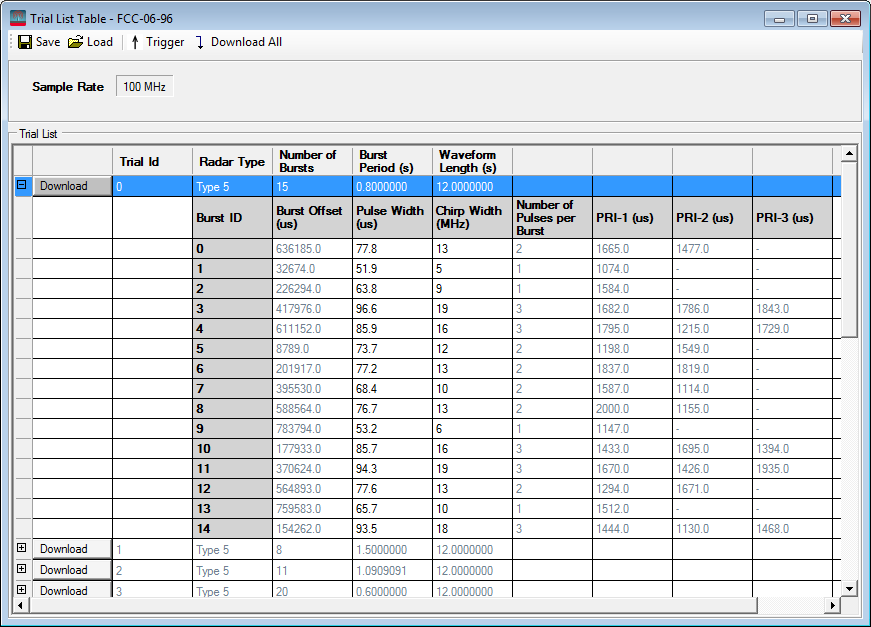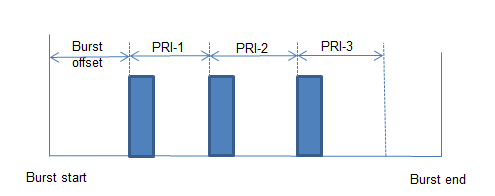
The Federal Communications Commission (FCC) DFS standard FCC 06-96 defines the types of radar waveforms that unlicensed devices operating in 5250~5350 MHz and 5470~5725 MHz should be able to detect.It identifies six radar test types, including three basic categories of radar waveform simulations:
Short pulse radar waveform is comprised of a number of pulses. The table below lists the parameters for waveforms of type 1~4. The pulse width, PRI and number of pulses are randomly selected from the range listed.
For Short Pulse Radar Type 1, the same waveform is used a minimum of 30 times. If more than 30 waveforms are used for Short Pulse Radar Types 2 through 4, then each additional waveform must also be unique and not repeated from the previous waveforms.
|
Radar Type |
Pulse Width (μs) | Pulse Repetition Interval PRI (μs) | Number of Pulses | Minimum Number of Trials |
|---|---|---|---|---|
|
1 |
1 | 1428 | 18 | 30 |
|
2 |
1~5 | 150~230 | 23~29 | 30 |
|
3 |
6~10 | 200~500 | 16~18 | 30 |
|
4 |
11~20 | 200~500 | 12~16 | 30 |
The long pulse radar test waveform consists of a series of bursts, randomly chosen between 8 and 20. Each burst has a series of chirp modulated pulses.
The transmission period of a long pulse radar test waveform is 12 second. This time is divided into equal durations depending on the number of bursts (8~20).
As listed in the table below, a burst may contain one, two, or three pulses. The pulse width and FM chirp deviation are randomly chosen for each burst and are the same for all pulses within one burst. In contrast, the pulses inside one burst can have different PRIs.
|
Radar Type |
Pulse Width (μs) | Chirp Width (MHz) | Pulse Repetition Interval PRI (μs) | Number of Pulses per Burst | Number of Bursts | Minimum Number of Trials |
|---|---|---|---|---|---|---|
|
5 |
50~100 | 5~20 | 1000~2000 | 1~3 | 8~20 | 30 |
To generate the long pulse radar test waveform, N7607C Signal Studio for DFS and DAA 2025 Update 1.0 software uses the parameter structure as below. You can see that in each waveform, there are a number of bursts, with the number randomly chosen from 8~20. And in each burst, there are parameters like bust offset, PRI-1, PRI-2, etc. Figure 2 shows the relationship of these parameters. Burst offset is randomly chosen in the range from 1 μs to (Burst Period – (PRI-1) – (PRI-2) – (PRI-3)).

Figure 1. Parameter Structure for Long Pulse Radar Test Waveform Generation

Figure 2. Graphical Representation for Relationships of Parameters in Each Burst
The frequency hopping radar waveform contains 100 bursts, each of which operating on a different frequency point. The 100-length frequency hopping sequence is randomly selected out of 475 integer frequencies from 5250 to 5724 MHz without any repetition. Each burst consists of 9 pulses with 1 μs pulse width and 333 μs PRI.
Refer to Simulated Frequency Hopping Generation for more details of how the frequency hopping radar signals are generated in the signal generator.
|
Radar Type |
Pulse Width (μs) | Pulse Repetition Interval PRI (μs) | Pulses per Hop | Hopping Rate (kHz) | Hopping Sequence Length (ms) | Minimum Number of Trials |
|---|---|---|---|---|---|---|
|
6 |
1 | 333 | 9 | 0.333 | 300 | 30 |